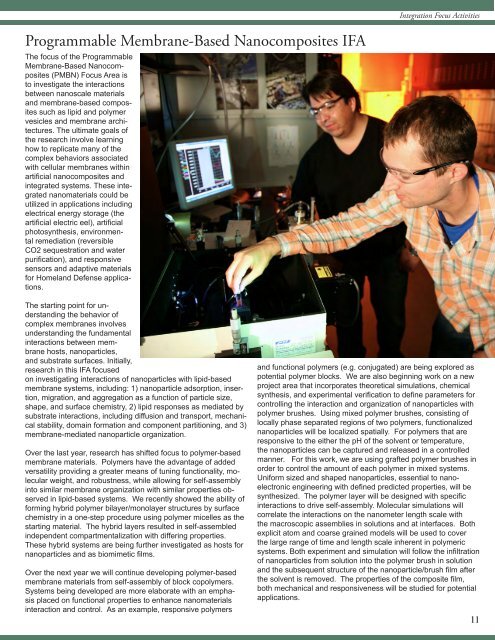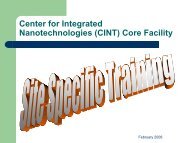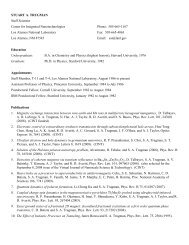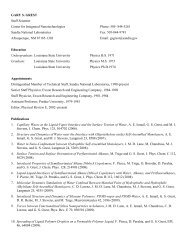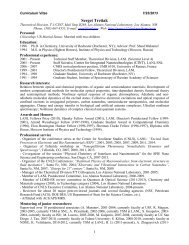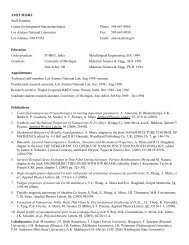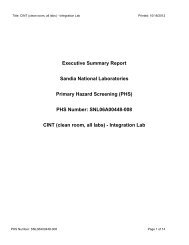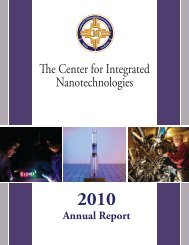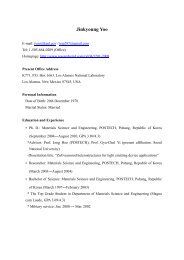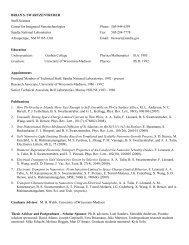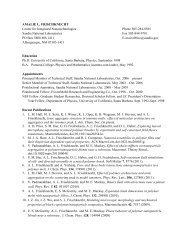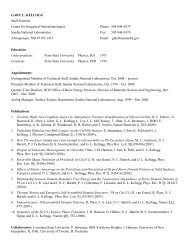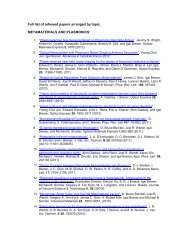2011 Annual Report - Center for Integrated Nanotechnologies - Los ...
2011 Annual Report - Center for Integrated Nanotechnologies - Los ...
2011 Annual Report - Center for Integrated Nanotechnologies - Los ...
You also want an ePaper? Increase the reach of your titles
YUMPU automatically turns print PDFs into web optimized ePapers that Google loves.
Integration Focus Activities<br />
Programmable Membrane-Based Nanocomposites IFA<br />
The focus of the Programmable<br />
Membrane-Based Nanocomposites<br />
(PMBN) Focus Area is<br />
to investigate the interactions<br />
between nanoscale materials<br />
and membrane-based composites<br />
such as lipid and polymer<br />
vesicles and membrane architectures.<br />
The ultimate goals of<br />
the research involve learning<br />
how to replicate many of the<br />
complex behaviors associated<br />
with cellular membranes within<br />
artificial nanocomposites and<br />
integrated systems. These integrated<br />
nanomaterials could be<br />
utilized in applications including<br />
electrical energy storage (the<br />
artificial electric eel), artificial<br />
photosynthesis, environmental<br />
remediation (reversible<br />
CO2 sequestration and water<br />
purification), and responsive<br />
sensors and adaptive materials<br />
<strong>for</strong> Homeland Defense applications.<br />
The starting point <strong>for</strong> understanding<br />
the behavior of<br />
complex membranes involves<br />
understanding the fundamental<br />
interactions between membrane<br />
hosts, nanoparticles,<br />
and substrate surfaces. Initially,<br />
research in this IFA focused<br />
on investigating interactions of nanoparticles with lipid-based<br />
membrane systems, including: 1) nanoparticle adsorption, insertion,<br />
migration, and aggregation as a function of particle size,<br />
shape, and surface chemistry, 2) lipid responses as mediated by<br />
substrate interactions, including diffusion and transport, mechanical<br />
stability, domain <strong>for</strong>mation and component partitioning, and 3)<br />
membrane-mediated nanoparticle organization.<br />
Over the last year, research has shifted focus to polymer-based<br />
membrane materials. Polymers have the advantage of added<br />
versatility providing a greater means of tuning functionality, molecular<br />
weight, and robustness, while allowing <strong>for</strong> self-assembly<br />
into similar membrane organization with similar properties observed<br />
in lipid-based systems. We recently showed the ability of<br />
<strong>for</strong>ming hybrid polymer bilayer/monolayer structures by surface<br />
chemistry in a one-step procedure using polymer micelles as the<br />
starting material. The hybrid layers resulted in self-assembled<br />
independent compartmentalization with differing properties.<br />
These hybrid systems are being further investigated as hosts <strong>for</strong><br />
nanoparticles and as biomimetic films.<br />
Over the next year we will continue developing polymer-based<br />
membrane materials from self-assembly of block copolymers.<br />
Systems being developed are more elaborate with an emphasis<br />
placed on functional properties to enhance nanomaterials<br />
interaction and control. As an example, responsive polymers<br />
and functional polymers (e.g. conjugated) are being explored as<br />
potential polymer blocks. We are also beginning work on a new<br />
project area that incorporates theoretical simulations, chemical<br />
synthesis, and experimental verification to define parameters <strong>for</strong><br />
controlling the interaction and organization of nanoparticles with<br />
polymer brushes. Using mixed polymer brushes, consisting of<br />
locally phase separated regions of two polymers, functionalized<br />
nanoparticles will be localized spatially. For polymers that are<br />
responsive to the either the pH of the solvent or temperature,<br />
the nanoparticles can be captured and released in a controlled<br />
manner. For this work, we are using grafted polymer brushes in<br />
order to control the amount of each polymer in mixed systems.<br />
Uni<strong>for</strong>m sized and shaped nanoparticles, essential to nanoelectronic<br />
engineering with defined predicted properties, will be<br />
synthesized. The polymer layer will be designed with specific<br />
interactions to drive self-assembly. Molecular simulations will<br />
correlate the interactions on the nanometer length scale with<br />
the macroscopic assemblies in solutions and at interfaces. Both<br />
explicit atom and coarse grained models will be used to cover<br />
the large range of time and length scale inherent in polymeric<br />
systems. Both experiment and simulation will follow the infiltration<br />
of nanoparticles from solution into the polymer brush in solution<br />
and the subsequent structure of the nanoparticle/brush film after<br />
the solvent is removed. The properties of the composite film,<br />
both mechanical and responsiveness will be studied <strong>for</strong> potential<br />
applications.<br />
11


